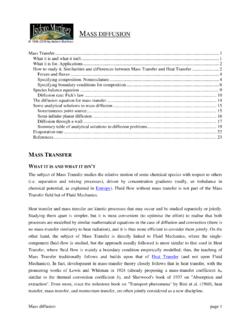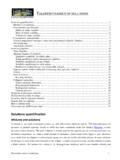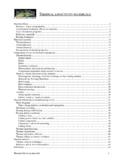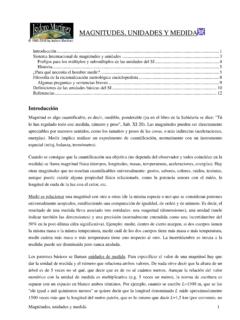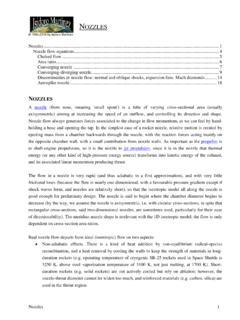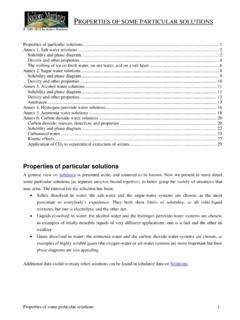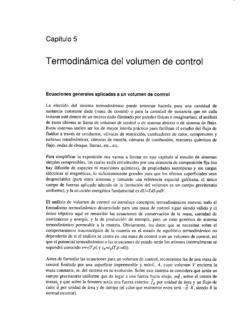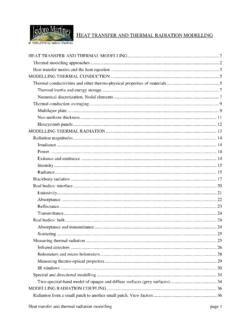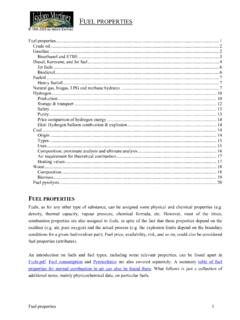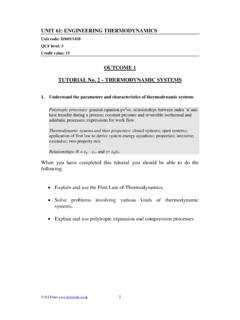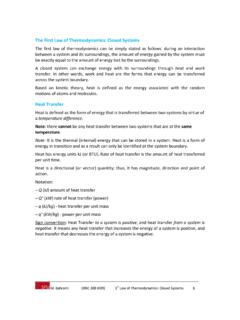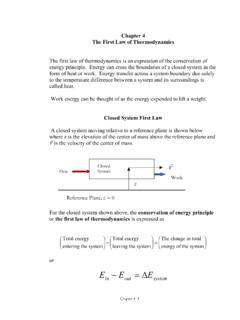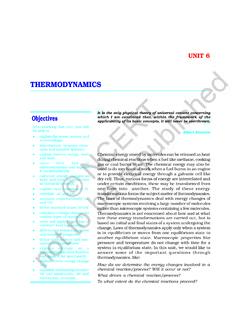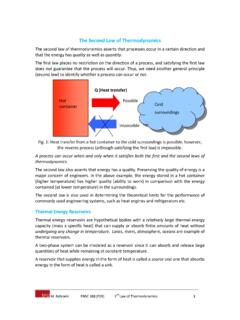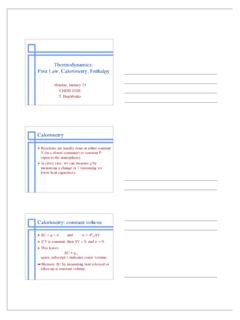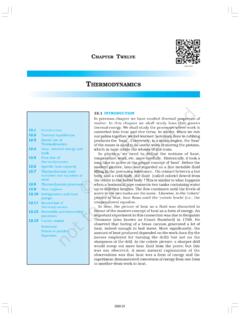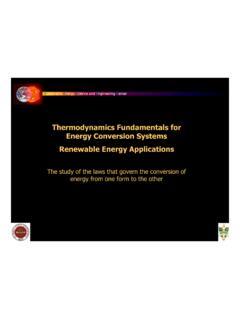Transcription of HEAT AND MASS TRANSFER - UPM
1 Heat and mass TRANSFER page 1 HEAT AND MASS TRANSFER Why heat and mass TRANSFER ..1 Fundamentals of heat TRANSFER (what is it) ..2 Thermodynamics of heat TRANSFER .. 3 Physical transport phenomena .. 5 Thermal conductivity .. 7 Heat equation .. 10 Modelling space, time and equations .. 11 Case studies .. 12 Nomenclature refresh .. 12 Objectives of heat TRANSFER (what for) ..13 Relaxation time .. 14 Conduction driven case (convection dominates) .. 15 Convection driven case (conduction dominates) .. 16 Heat flux .. 17 Temperature field .. 19 Dimensioning for thermal design .. 20 Procedures (how it is done) ..21 Thermal design .. 21 Thermal analysis .. 21 Mathematical modelling.
2 22 Modelling the geometry .. 23 Modelling materials properties .. 24 Modelling the heat equations .. 25 Analysis of results .. 26 Modelling heat conduction ..27 Modelling mass diffusion ..27 Modelling heat and mass convection ..27 Modelling thermal radiation ..27 General equations of physico-chemical processes ..27 Books on Heat and Mass TRANSFER ..27 WHY HEAT AND MASS TRANSFER Heat TRANSFER and mass TRANSFER are kinetic processes that may occur and be studied separately or jointly. Studying them apart is simpler, but both processes are modelled by similar mathematical equations in the case of diffusion and convection (there is no mass- TRANSFER similarity to heat radiation), and it is thus more efficient to consider them jointly.
3 Besides, heat and mass TRANSFER must be jointly considered in some cases like evaporative cooling and ablation. The usual way to make the best of both approaches is to first consider heat TRANSFER without mass TRANSFER , and present at a later stage a briefing of similarities and differences between heat TRANSFER and mass TRANSFER , with some specific examples of mass TRANSFER applications. Following that procedure, we forget for the Heat and mass TRANSFER page 2 moment about mass TRANSFER (dealt with separately under Mass TRANSFER ), and concentrate on the simpler problem of heat TRANSFER . There are complex problems where heat and mass TRANSFER processes are combined with chemical reactions, as in combustion; but many times the chemical process is so fast or so slow that it can be decoupled and considered apart, as in the important diffusion-controlled combustion problems of gas-fuel jets, and condensed fuels (drops and particles), which are covered under Combustion kinetics.
4 Little is mentioned here about heat TRANSFER in the micrometric range and below, or about biomedical heat TRANSFER (see Human thermal comfort). FUNDAMENTALS OF HEAT TRANSFER (WHAT IS IT) Heat TRANSFER is the flow of thermal energy driven by thermal non-equilibrium ( the effect of a non-uniform temperature field), commonly measured as a heat flux (vector), the heat flow per unit time (and usually unit normal area) at a control surface. The aim here is to understand heat TRANSFER modelling, but the actual goal of most heat TRANSFER (modelling) problems is to find the temperature field and heat fluxes in a material domain, given a previous knowledge of the subject (general partial differential equations, PDE), and a set of particular constraints: boundary conditions (BC), initial conditions (IC), distribution of sources or sinks (loads), etc.
5 There are also many cases where the interest is just to know when the heat- TRANSFER process finishes, and in a few other cases the goal is not in the direct problem (given the PDE+BC+IC, find the T-field) but on the inverse problem: given the T-field and some aspects of PDE+BC+IC, find some missing parameters (identification problem), finding the required dimensions or materials for a certain heat insulation or conduction goal. Heat- TRANSFER problems arise in many industrial and environmental processes, particularly in energy utilization, thermal processing, and thermal control. Energy cannot be created or destroyed, but so-common it is to use energy as synonymous of exergy, or the quality of energy, than it is commonly said that energy utilization is concerned with energy generation from primary sources ( fossil fuels, solar), to end-user energy consumption ( electricity and fuel consumption), through all possible intermediate steps of energy valorisation, energy transportation, energy storage, and energy conversion processes.
6 The purpose of thermal processing is to force a temperature change in the system that enables or disables some material transformation ( food pasteurisation, cooking, steel tempering or annealing). The purpose of thermal control is to regulate within fixed established bounds, or to control in time within a certain margin, the temperature of a system to secure its correct functioning. As a model problem, consider the thermal problem of heating a thin metallic rod by grasping it at one end with our fingers for a while, until we withdraw our grip and let the rod cool down in air; we may want to predict the evolution of the temperature at one end, or the heat flow through it, or the rod conductivity needed to heat the opposite end to a given value.
7 We may learn from this case study how difficult it is to model the heating by our fingers, the extent of finger contact, the thermal convection through the air, etc. By Heat and mass TRANSFER page 3 the way, if this example seems irrelevant to engineering and science (nothing is irrelevant to science), consider its similarity with the heat gains and losses during any temperature measurement with a typical 'long' thermometer (from the old mercury-in-glass type. to the modern shrouded thermocouple probe). A more involved problem may be to find the temperature field and associated dimensional changes during machining or cutting a material, where the final dimensions depend on the time-history of the temperature field.
8 Everybody has been always exposed to heat TRANSFER problems in normal life (putting on coats and avoiding winds in winter, wearing caps and looking for breezes in summer, adjusting cooking power, and so on), so that certain experience can be assumed. However, the aim of studying a discipline is to understand it in depth; to clearly distinguish thermal-conductivity effects from thermal-capacity effects, the relevance of thermal radiation near room temperatures, and to be able to make sound predictions. Typical heat- TRANSFER devices like heat exchangers, condensers, boilers, solar collectors, heaters, furnaces, and so on, must be considered in a heat- TRANSFER course, but the emphasis must be on basic heat- TRANSFER models, which are universal, and not on the myriad of details of past and present equipment.
9 Heat TRANSFER theory is based on thermodynamics, physical transport phenomena, physical and chemical energy dissipation phenomena, space-time modelling, additional mathematical modelling, and experimental tests. Thermodynamics of heat TRANSFER Heat TRANSFER is the relaxation process that tends to do away with temperature gradients (recall that T 0 in an isolated system), but systems are often kept out of equilibrium by imposed boundary conditions. Heat TRANSFER tends to change the local state according to the energy balance, which for a closed system is: What is heat ( heat flow)? Q E W Q = E|V,non-dis= H|p,non-dis (1) heat, Q ( the flow of thermal energy from the surroundings into the system, driven by thermal non-equilibrium, not related to work or to the flow of matter), equals the increase in stored energy, E, minus the flow of work, W.
10 For non-dissipative systems ( without mechanical or electrical dissipation), heat equals the internal energy change if the process is at constant volume, or the enthalpy change if the process is at constant volume, both cases converging for a perfect substance model (PSM, constant thermal capacity) to Q=mc T. However, it is worth to keep in mind that: Heat is the flow of thermal energy driven by thermal non-equilibrium, so that 'heat flow' is a redundancy ( a pleonasm, and the same for work flow ). Heat must not be confused with stored thermal energy, and moving a hot object from one place to another must not be called heat TRANSFER .
